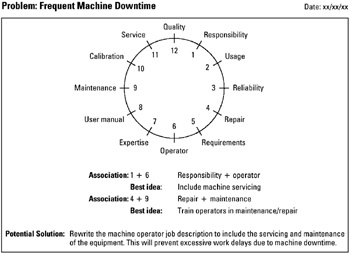Tool 30: Circle of Opportunity
| AKA | Free Association |
| Classification | Idea Generating (IG) |
Tool description
The circle of opportunity technique is a process of randomly selecting problem related characteristics or attributes and, by free association, arriving at original and new ideas or possible solutions. As associations are formed or links completed, new relationships, insights, or possibilities produce additional novel ideas for consideration and study by a team.
Typical application
-
To discover new meanings, relationships, or word associations and, by concentrated study, to produce new thoughts on solving problems or improving products and services.
-
To free-associate attributes for the purpose of surfacing original ideas for problems solving or process improvement.
-
To selectively study randomly linked word combination in search of ideas or solutions.
Problem-solving phase
| Select and define problem or opportunity | |
| → | Identify and analyze causes or potential change |
| → | Develop and plan possible solutions or change |
| Implement and evaluate solution or change | |
| Measure and report solution or change results | |
| Recognize and reward team efforts |
Typically used by
| Research/statistics | |
| 1 | Creativity/innovation |
| Engineering | |
| Project management | |
| 3 | Manufacturing |
| Marketing/sales | |
| Administration/documentation | |
| Servicing/support | |
| 3 | Customer/quality metrics |
| 2 | Change management |
before
-
Attribute Listing
-
Fresh Eye
-
Mental Imaging
-
Forced Choice
-
Circumrelation
after
-
Stimulus Analysis
-
Idea Advocate
-
Opportunity Analysis
-
Information Needs Analysis
-
Value analysis
Notes and key points
-
To ensure randomness, a pair of dice is needed to select characteristics or attributes listed around a closed circle (circle of opportunity).
Step-by-step procedure
-
STEP 1 The team facilitator displays a problem statement to the team participants. See example Problem: Frequent Machine Downtime.
-
STEP 2 A circle of opportunity is constructed as shown in the example.
-
STEP 3 Problem-related characteristics are identified by the team. The facilitator records these around the twelve circle of opportunity segments.
-
STEP 4 The facilitator throws one die to determine the first characteristic, then throws both dice to determine the second characteristic.
-
STEP 5 The team collectively free-associates using individual and combined word characteristics. The facilitator records on flip charts any associations and resulting ideas or insights as they are produced by the participants.
-
STEP 6 Connections or links to the problem are surfaced and analyzed. Any thoughts that may help to finalize a solution to the problem are also recorded.
-
STEP 7 Collectively, the participants produce a potential solution statement as seen in the example.
-
STEP 8 The circle of opportunity is dated and shown to the process owner.
Example of tool application

EAN: 2147483647
Pages: 326